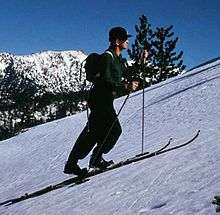Ski skins
Climbing skins are strips that attach to the bottom of nordic, alpine touring or randonnée skis to help while ascending backcountry slopes. They are designed to be removed for skiing downhill. They are typically attached to the skis via a loop on the ski tip, a hook on the tail, and adhesive on the base of the skin. They are called skins because they resemble sealskin, from which the first ski skins were made. They are typically made from nylon or mohair or a combination thereof, and are designed to let the ski slide forward on snow but not backward.[1][2] They are usually narrower than the ski to allow the ski edges to get a grip. Some ski resorts permit skinning.[3][4]


History
Various ethnic groups living in the Arctic regions created a means of transportation across the ice and snow surfaces of their regions, with innovations such as the ski. Attuned to maximizing the use of their materials, one outcome of their innovation was the use of animal skins to gain traction in traveling. As these groups were nomadic, the technology of skis for transportation was integral to continual movement across the region, as well as in maximizing transportation speed while reducing energy expenditure.[5]
References
- Lind, David A.; Sanders, Scott (2013). The Physics of Skiing: Skiing at the Triple Point (2 ed.). Springer Science & Business Media. p. 270. ISBN 1475743459. Retrieved 2016-01-30.
- "Climbing skins". MEC. Retrieved 14 November 2014.
- Cranmore Mountain Resort: Uphill Travel, accessed 18 July 2017
- Bolton Valley Uphill Policy, accessed 7 February 2020
- Formenti, Federico; et al. (2005). "Human Locomotion on Snow: Determinants of Economy and Speed of Skiing across the Ages". Proceedings: Biological Sciences. 272 (1572): 1561–1569. doi:10.1098/rspb.2005.3121. JSTOR 30047725. PMC 1559840. PMID 16048771.
External links
